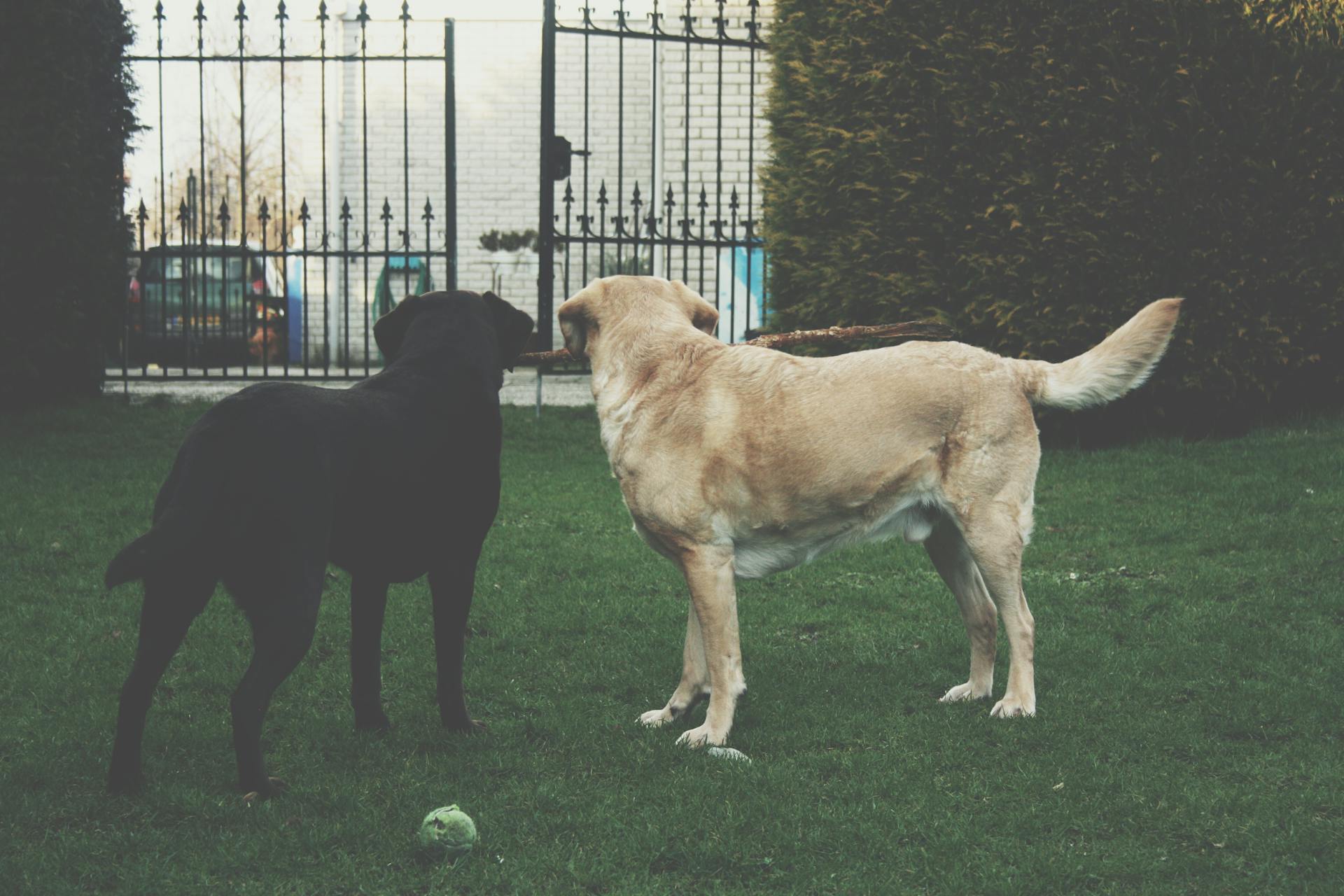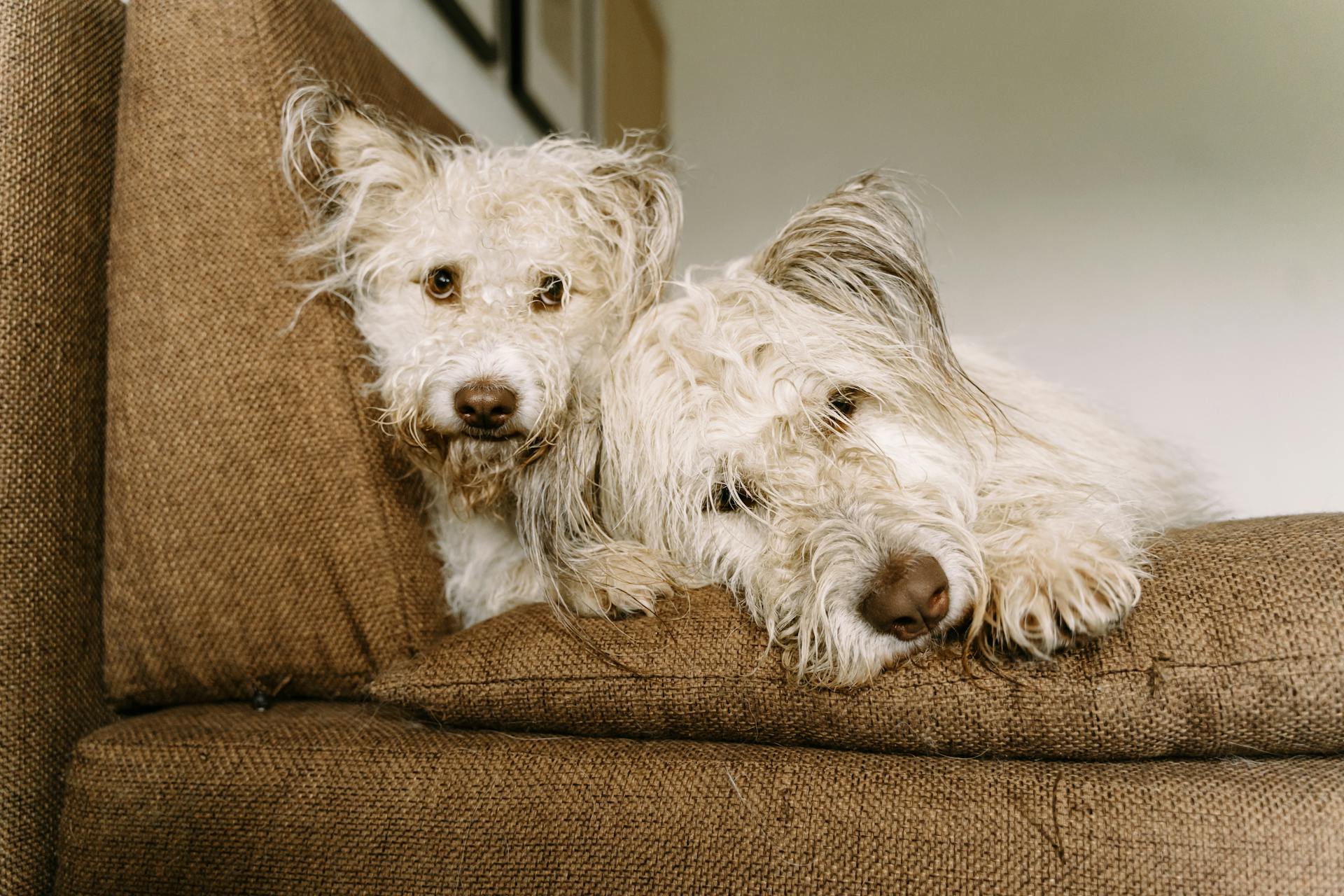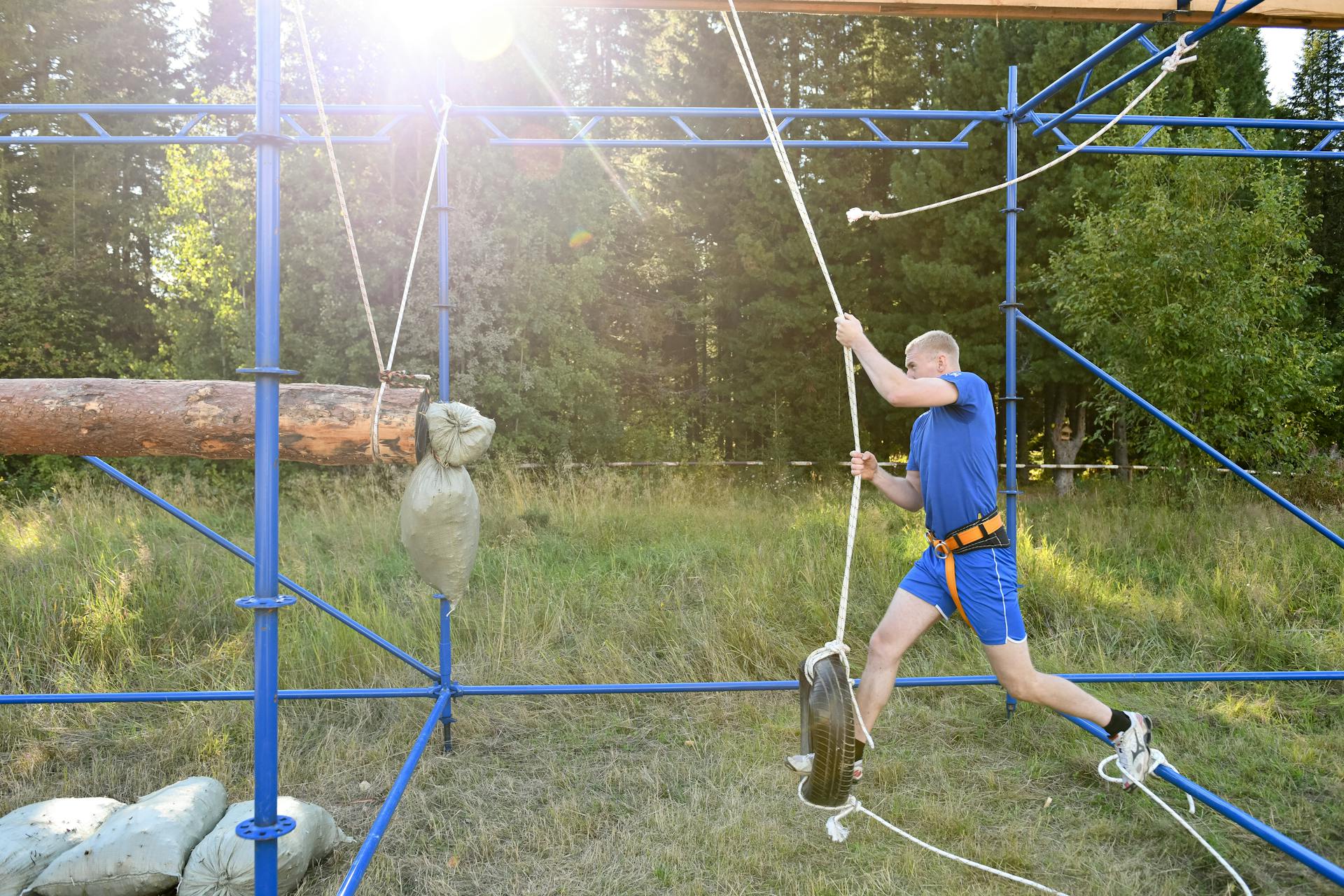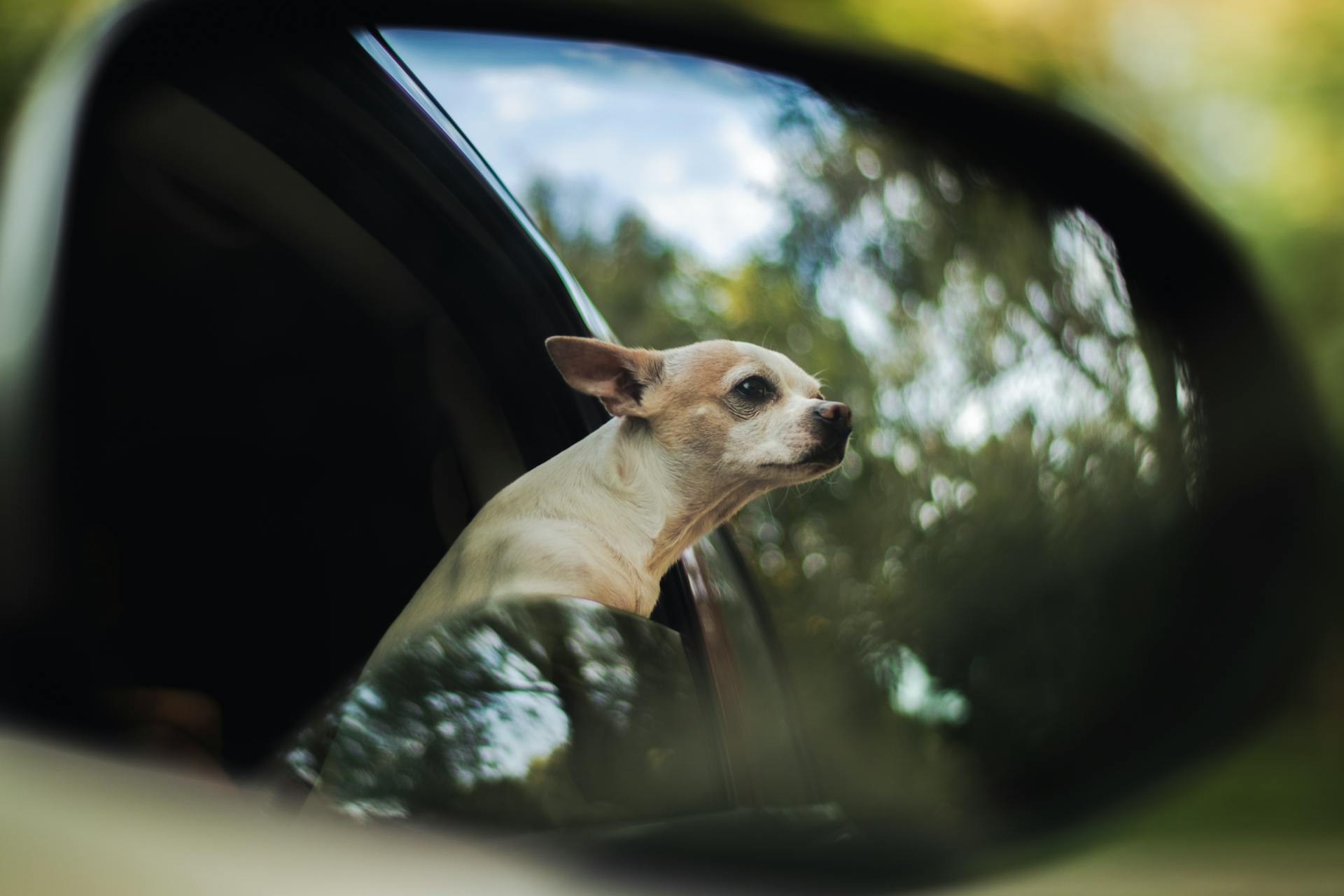
Separation anxiety in Maltipoos can be a real challenge for both dogs and their owners.
Maltipoos are prone to separation anxiety due to their high attachment level to their owners, which can be a result of their strong social nature. They thrive on interaction and attention.
Some Maltipoos may exhibit destructive behavior such as chewing or digging when left alone, while others may become vocal and whine. In extreme cases, they may even escape from the house.
It's essential to establish a consistent routine to help your Maltipoo feel secure and calm when you're away from home.
Causes of Separation Anxiety
Genetics play a significant role in a Maltipoo's predisposition to separation anxiety. This can be seen in their inherited traits from parent breeds, such as intelligence and sensitivity.
Maltipoos are genetically predisposed to anxiety because of their parent breeds, Maltese and Poodles, which are known for their high-strung temperaments and sensitivity to their environment.
Worth a look: Dogs with Separation Anxiety Breeds
Early life experiences, such as being separated from their mothers too early or experiencing traumatic events, can shape a Maltipoo's behavior and emotional health, increasing the likelihood of separation anxiety.
A Maltipoo's environment can also contribute to separation anxiety, with factors such as the owner's behavior playing a significant role. If an owner is overly anxious or protective, the dog may pick up on these emotions and become anxious as well.
Here are some key factors to consider:
- Role of Breed: Maltipoos inherit intelligence and sensitivity from their parent breeds, making them more susceptible to anxiety.
- Genetic Predisposition: Maltipoos are genetically predisposed to anxiety due to their parent breeds' high-strung temperaments and sensitivity.
- Early Life Experiences: Puppies that experience traumatic events or are separated from their mothers too early are more likely to develop separation anxiety.
- Owner's Behavior: The owner's anxiety or protective behavior can trigger separation anxiety in Maltipoos.
Genetic Factors
Genetic Factors play a significant role in a Maltipoo's susceptibility to separation anxiety. This is due to the specific traits that have been bred into them, making them more prone to anxiety when left alone.
Some dog breeds are more prone to separation anxiety than others, and Maltipoos are one of them. This is because of the intelligence and sensitivity they inherit from their parent breeds, the Maltese and Poodles.
Maltipoos are genetically predisposed to anxiety because of their parent breeds' high-strung temperaments and sensitivity to their environment. This means that Maltipoos are more likely to develop separation anxiety compared to other breeds.
A different take: Maltipoo Mixed Breeds
Both Maltese and Poodles are known for their sensitive nature, which is passed down to their offspring. This is why Maltipoos are more likely to experience separation anxiety.
Here are the key genetic factors that contribute to separation anxiety in Maltipoos:
- Role of Breed in Separation Anxiety: Maltipoos inherit the intelligence and sensitivity of their parent breeds, making them more susceptible to anxiety when left alone.
- Maltipoo’s Genetic Predisposition to Anxiety: Maltipoos are genetically predisposed to anxiety because of their parent breeds' high-strung temperaments and sensitivity to their environment.
What If My Dog Has?
Your Maltipoo cries or growls when left at home alone, and they become incredibly clingy when you return, afraid that you're going to leave them again.
In the worst-case scenario, your Maltipoo might destroy objects in the home, such as furniture or plants, due to their separation anxiety.
Dogs that suffer from separation anxiety can be prone to destructive behavior, so it's essential to address the issue early on.
You may find that your Maltipoo's personality determines the severity of their separation anxiety, with some dogs never experiencing it, while others suffer from severe cases.
Take a look at this: Home Remedies for Separation Anxiety in Dogs
Symptoms and Behavior
Maltipoo separation anxiety can manifest in various ways, and it's essential to recognize the symptoms early to provide the necessary support.
Excessive barking or howling is a common sign of anxiety in Maltipoos, often occurring when they're left alone or separated from their owners.
Chewing, digging, and destruction can be a way for Maltipoos to release pent-up energy or stress, so be on the lookout for these behaviors.
Escaping when left alone or separated is a clear indication of separation anxiety, often accompanied by scratching doors or chewing through barriers.
Physical symptoms like trembling, panting, or excessive drooling can also indicate anxiety in Maltipoos, especially if they're not typically triggered by fear or stress.
Maltipoos with anxiety may resort to destructive behaviors, such as chewing on furniture or digging holes in the yard, which can be a sign of distress.
If you notice any of these symptoms, it's crucial to consult with a veterinarian or a professional dog trainer to discuss possible treatments and strategies to help your pet cope with their anxiety.
Here are some common anxiety-related behavior problems in Maltipoos:
- Aggression: Maltipoos may become snappy, growl, or bite when they feel threatened or scared.
- Depression: Maltipoos with anxiety may show signs of depression, such as loss of interest in activities, changes in eating and sleeping habits, and a general lack of energy.
- Compulsive behavior: Maltipoos may exhibit behaviors like excessive licking or chewing, pacing, or repetitive barking as a way to cope with their anxiety.
Treatment Options
Seeking professional help is a crucial step in treating your Maltipoo's separation anxiety. You can consult with a veterinarian to rule out any underlying medical conditions contributing to the anxiety.
A veterinarian can provide advice on potential treatments, which may include medication or behavioral therapy. They can also conduct a thorough examination to identify any medical conditions that may be exacerbating the anxiety.
Working with a professional dog trainer is another valuable resource. They can help your Maltipoo feel more secure when left alone and teach you techniques to reinforce this training at home. Consistency is key when it comes to training.
Here are some professional resources you can turn to:
- Consulting with a Veterinarian
- Working with a Professional Dog Trainer
Prescription medications can be effective in managing severe separation anxiety in Maltipoos. These medications are prescribed by a veterinarian and can alter the chemical balance in your dog's brain to help them feel calmer.
Over-the-counter remedies, such as calming sprays, diffusers, and chews, can also be helpful in managing mild to moderate separation anxiety. These products often contain natural ingredients like chamomile and lavender, which are known for their calming properties.
Some popular anti-anxiety supplements for Maltipoos include those containing L-Tryptophan, L-Theanine, or Melatonin. These ingredients can help regulate your dog's mood and reduce anxiety.
In severe cases of separation anxiety, a professional behaviorist can be a valuable resource. They can help you understand why your dog is anxious about being left alone and provide guidance on how to decrease their stress.
A fresh viewpoint: Calming Signals
Training and Management
Training and management are crucial in helping your Maltipoo overcome separation anxiety. Establishing a routine is a great place to start, as it provides your Maltipoo with a sense of security and predictability.
Having a consistent schedule can help reduce anxiety levels in Maltipoos. For instance, feeding your Maltipoo at the same time every day can help them understand that they will not be left without food, which can be a significant source of anxiety for many dogs.
Consider reading: Can Neutering a Dog Reduce Aggression
Gradual desensitization is another effective technique for managing separation anxiety in Maltipoos. This involves slowly getting your Maltipoo used to being alone by leaving them alone for short periods of time and gradually increasing the length of time they are left alone.
Providing a safe space for your Maltipoo can also help manage their separation anxiety. This could be a specific room or a crate where they feel secure, filled with their favorite toys and blankets.
To make your Maltipoo's alone time a success, consider providing mentally stimulating toys like puzzle feeders, making sure they have access to their bed, food, and clean water, exercising them before you leave, and leaving the radio on.
Here are some tips for leaving your Maltipoo alone:
- Provide mentally stimulating toys like puzzle feeders
- Make sure your Maltipoo has access to their bed, food, and clean water
- Exercise your Maltipoo before you leave
- Leave the radio on
- Crate train your Maltipoo to help them feel safe while you're gone
- Consider hiring a dog walker/pet sitter to check in with your dog and take them for a stroll
- Consider asking a neighbor or someone you trust to check in with your dog and take them for a bathroom break if they're going to be alone for more than a few hours.
Leaving Your Dog Alone
Working with a professional behaviorist can help you understand why your Maltipoo is anxious about you leaving and how to decrease their stress.
Maltipoos can stay at home alone, but it's not recommended for extended periods. In fact, leaving them alone for too long can lead to separation anxiety, which can cause them to cry, growl, or even destroy objects in the home.
Broaden your view: How Long Can a Maltipoo Be Left Alone
To make your Maltipoo's alone time a success, provide mentally stimulating toys, make sure they have access to their bed, food, and clean water, and exercise them before you leave to tire them out and reduce their stress.
Here are some general guidelines for how long a dog can be left alone:
How Long Can Be Left Alone?
Leaving your Maltipoo alone can be a challenge, but understanding how long they can handle it is key. A healthy adult Maltipoo can be left alone for a maximum of 6-8 hours.
Maltipoos are social dogs that need interaction to stay entertained, so leaving them alone for too long can lead to loneliness and separation anxiety. If you do need to leave your Maltipoo alone, make sure they have everything they need to be comfortable and entertained.
For puppies, the time is shorter because their needs are different. They can't be left alone for more than 1 hour at 10 weeks, 2 hours at 10-12 weeks, and 3 hours at 3 months.
You might enjoy: Healthy Mind Canine - Separation Anxiety Training
Here's a breakdown of the general guidelines for how long a dog can be left alone, according to the American Kennel Club:
Senior dogs and dogs with health issues also have a shorter threshold in terms of how much time they can spend alone.
Staying Home Alone
Staying home alone can be a challenge for both you and your Maltipoo. Most Maltipoos can stay at home alone, but it's not recommended for extended periods.
You can start by leaving your Maltipoo alone for short periods, and they'll get used to it. However, Maltipoos are very social dogs and need interaction with humans or other dogs to stay entertained.
A healthy adult Maltipoo with no anxiety issues can be left alone at home for a maximum of 6–8 hours, providing they have everything they need to be comfortable and entertained while you're away. But, for puppies, the time is shorter, and senior dogs and dogs with health issues also have a shorter threshold.
Discover more: Sit Stay Dog Training
To make your Maltipoo's alone time a success, you can provide mentally stimulating toys like puzzle feeders, make sure they have access to their bed, food, and clean water, and exercise them before you leave to tire them out and reduce their stress.
Here are some general guidelines for how long a dog can be left alone:
It's also a good idea to socialize with your Maltipoo before leaving them alone, take them for a walk shortly before you leave, and leave some water and food for them to access.
Sources
- https://poodlecuddle.com/managing-maltipoos-separation-anxiety-causes-solutions/
- https://www.hepper.com/can-maltipoos-be-left-alone/
- https://www.oodlelife.com/can-maltipoos-stay-at-home-alone/
- https://iheartdogs.com/7-sure-fire-ways-to-calm-your-malteses-anxiety/
- https://maltipooexpert.com/maltipoo-puppy-whining-and-crying/
Featured Images: pexels.com


